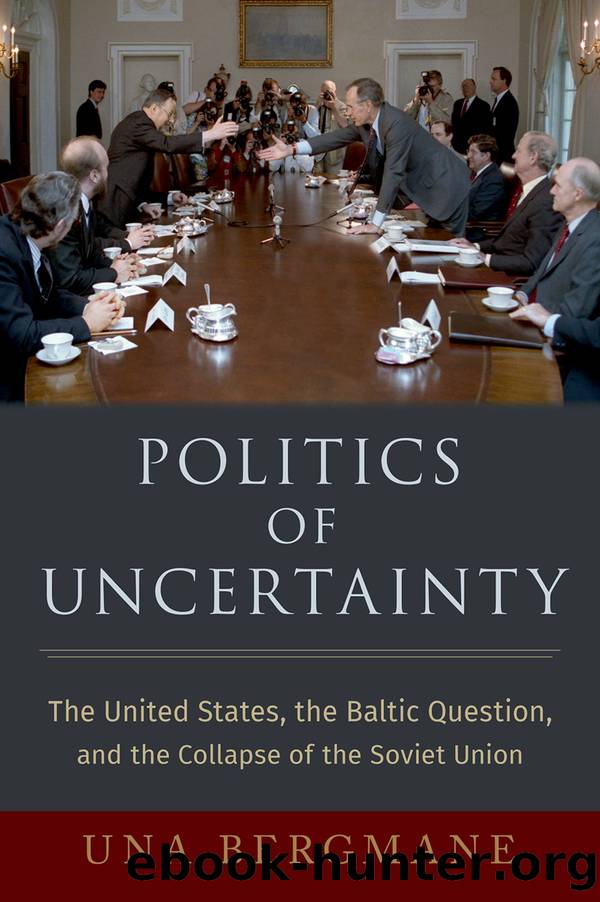Politics of Uncertainty by Una Bergmane;

Author:Una Bergmane;
Language: eng
Format: epub, pdf
Publisher: Oxford University Press USA
Published: 2022-06-15T00:00:00+00:00
European Outrage
The strongest reaction to the Soviet use of force came from the countries that for historical reasons were able to emotionally identify with the Balts. A sense of sameness, rooted in a shared fear of the Soviet other, and a shared cultural heritage were the driving forces behind civil-society reactions in Eastern and Northern Europe.
Small demonstrations, from a few dozen to hundreds of people, took place in Sofia and Oslo. More extensive demonstrations were staged in the Czech and Slovak Federative Republic, where several thousand people marched in the streets of Prague on January 13 and 14.123 In Finland, the Baltic question was particularly sensitive because of the discrepancy between public sympathy for the linguistically and culturally close Estonia, and the governmentâs strategy of keeping a neutral position vis-à -vis âSoviet internal problems.â In Helsinki between 300 and 400 people marched from the Soviet embassy to the presidentâs palace, calling for President Koivisto to resign.124 In Denmark, which over the previous months had emerged as one of the main advocates for Baltic independence, two of the countryâs biggest newspapers, the center-left Politiken and the conservative Berlingske Tidende, called their readers to a jointly organized protest in support of the Baltic states.125 The event assembled between 15,000 and 20,000 people. The Swedish tabloid Expressen urged its readers to write to the Soviet president and ask him to give Swedenâs neighbors âtheir national freedom back.â126 In Sweden, where there was a significant Baltic community, smaller demonstrations had already been held in Stockholm over several months, but after the shootings in Vilnius, up to 5,000 people assembled, including the Swedish, Latvian, and Estonian ministers of foreign affairs.127 On the morning of January 13, the heads of Latvian and Estonian diplomacy; the deputy speaker of the Latvian Supreme Soviet; the leader of Tautas Fronte, Dainis ĪvÄns; and the deputy speaker of the Lithuanian Supreme Soviet, Bronius Kuzmickas, arrived in Sweden with authority to create governments in exile. They were received by the Swedish foreign minister, Sten Andersson, who offered financial help for their stay in the West during the crisis. After having held a meeting to coordinate their actions, the foreign ministers left for a tour around Europe while the deputy speakers made their way to the United States.128
Meanwhile, the Lithuanian minister Algirdas Saudargas headed to Poland, where he was warmly welcomed by the parliament. It was in Poland that the most massive demonstration outside the Soviet Union took place. As the German press noted, the Soviet embassy in Warsaw and its consulates in GdaÅsk and Kraków were constantly besieged by protesters.129 In the days after January 13, demonstrations involving 15,000 people took place in all the most prominent Polish cities, marking not only Polish support to the Baltic nations but also a step toward a historic reconciliation between Poland and Lithuania.130 In an act of solidarity, a Polish parliamentary delegation joined their Lithuanian colleagues in the besieged parliament building and declared themselves ready to die by their side.131 A group of Swedish lawmakers traveled to Vilnius, Riga, and Tallinn and met with their Baltic counterparts.
Download
This site does not store any files on its server. We only index and link to content provided by other sites. Please contact the content providers to delete copyright contents if any and email us, we'll remove relevant links or contents immediately.
Cecilia; Or, Memoirs of an Heiress — Volume 1 by Fanny Burney(32029)
Cecilia; Or, Memoirs of an Heiress — Volume 3 by Fanny Burney(31441)
Cecilia; Or, Memoirs of an Heiress — Volume 2 by Fanny Burney(31389)
The Great Music City by Andrea Baker(30761)
We're Going to Need More Wine by Gabrielle Union(18611)
All the Missing Girls by Megan Miranda(14633)
Pimp by Iceberg Slim(13757)
Bombshells: Glamour Girls of a Lifetime by Sullivan Steve(13670)
Fifty Shades Freed by E L James(12892)
Talking to Strangers by Malcolm Gladwell(12835)
Norse Mythology by Gaiman Neil(12795)
For the Love of Europe by Rick Steves(11342)
Crazy Rich Asians by Kevin Kwan(8867)
Mindhunter: Inside the FBI's Elite Serial Crime Unit by John E. Douglas & Mark Olshaker(8672)
The Lost Art of Listening by Michael P. Nichols(7141)
Enlightenment Now: The Case for Reason, Science, Humanism, and Progress by Steven Pinker(6857)
The Four Agreements by Don Miguel Ruiz(6293)
Bad Blood by John Carreyrou(6260)
Weapons of Math Destruction by Cathy O'Neil(5805)
